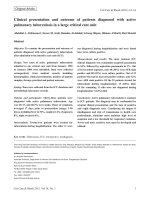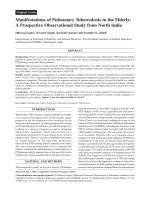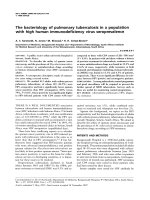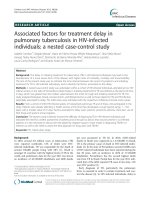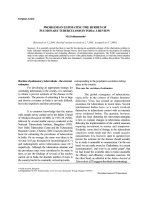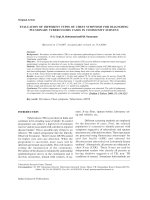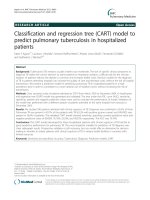Evaluation of a diagnostic algorithm for smear-negative pulmonary tuberculosis in HIV-infected adults doc
Bạn đang xem bản rút gọn của tài liệu. Xem và tải ngay bản đầy đủ của tài liệu tại đây (412.62 KB, 7 trang )
O
RIGINAL
A
RTICLES
517
July 2007, Vol. 97, No. 7 SAMJ
Tuberculosis (TB) is the commonest cause of morbidity and
mortality in HIV-infected people in sub-Saharan Africa.
1
The
mortality associated with TB is considerably higher in HIV-
infected than HIV-negative patients.
2
Furthermore, TB is a
more rapidly progressive disease in HIV-infected people.
3
This
means that any delay in the diagnosis of active TB in HIV co-
infected patients is more likely to result in clinical deterioration
and greater morbidity and mortality.
4
The diagnostic window
of opportunity is therefore narrower. Active TB has been found
at autopsy in around 50% of AIDS-related deaths in Africa,
5,6
and in almost half the diagnosis was not made ante-mortem.
5
This situation is complicated by the fact that TB is more
difficult to diagnose in HIV-infected patients. HIV modifies
the clinical presentation of TB, particularly in those with more
advanced immunosuppression. HIV-infected patients are twice
as likely to have sputum smear-negative, culture-positive
pulmonary TB (PTB).
7-9
This results from their compromised
immune response causing less cavity formation.
10
The sputum
smear has traditionally been used as the method for making
an early diagnosis of PTB. The reduction in sensitivity of this
test in HIV-infected patients leads to diagnostic delay. Sputum
culture is a more sensitive method of diagnosing PTB in such
cases, but can take up to 8 weeks before a result is available.
The patient’s condition invariably deteriorates during this
interval. Other factors contributing to diagnostic delay are that
patients with HIV-associated PTB present more commonly with
atypical or normal chest radiographs
11,12
and extrapulmonary
tuberculosis (EPTB) is more common in the context of HIV
infection.
13
This diagnostic delay also results in increased hospitalisation
and increased costs to the health system. It has also been
proposed that delay in the initiation of TB treatment may
accelerate HIV infection.
14
It is imperative that efforts be made to expedite the diagnosis
of TB in HIV-infected people. While new diagnostic techniques
are being developed and methods such as sputum induction
have been shown to increase the yield of the sputum smear,
15
these are unavailable in most primary care settings in South
Africa. It is often necessary to make a clinico-radiological
diagnosis of smear-negative TB (SNTB) using an algorithm
and to initiate empirical TB treatment while awaiting culture
results. The sensitivity and specificity of clinical algorithms
Evaluation of a diagnostic algorithm for smear-negative
pulmonary tuberculosis in HIV-infected adults
P Saranchuk, A Boulle, K Hilderbrand, D Coetzee, M Bedelu, G van Cutsem, G Meintjes
Médecins Sans Frontières, Cape Town
P Saranchuk, MD, CCFP, DTM&H
K Hilderbrand, BSc Hons, MSc, CESAM
M Bedelu, MB ChB, MPH
G van Cutsem, MD, DTM&H
Infectious Disease Epidemiology Unit, School of Public Health and Family Medicine,
University of Cape Town
A Boulle, MB ChB, MSc, FCPHM (SA)
D Coetzee, MB BCh, DTM&H, MS, FCPHM (SA)
HIV Service and Department of Medicine, G F Jooste Hospital, and Department of
Medicine, University of Cape Town
G Meintjes, MB ChB, FCP (SA), MRCP (UK), DipHIVMan (SA)
Objectives. To evaluate the diagnostic accuracy of and reduction
in diagnostic delay attributable to a clinical algorithm used
for the diagnosis of smear-negative pulmonary tuberculosis
(SNPTB) in HIV-infected adults.
Design. An algorithm was designed to facilitate clinico-
radiological diagnosis of pulmonary TB (PTB) in HIV-infected
smear-negative adult patients. A folder review was performed
on the first 58 cases referred for empirical TB treatment using
this algorithm.
Setting. Nolungile HIV Clinic, Site C, Khayelitsha.
Subjects. Subjects included 58 HIV-infected adult patients with
suspected PTB consecutively referred to the local TB clinic
for outpatient TB treatment using this algorithm between 12
February 2004 and 30 April 2005.
Outcome measures. Outcome measures were response of
C-reactive protein, haemoglobin, weight and symptoms to TB
treatment, and TB culture result. Diagnostic delay (in days)
was calculated.
Results. Thirty-two of the 58 patients (55%) had positive TB
cultures (definite TB). Initiation of TB treatment occurred
on average 19.5 days before the positive culture report. A
further 21 patients (36%) demonstrated clinical improvement
on empirical treatment (probable/possible TB). Two patients
did not improve and subsequently died without a definitive
diagnosis. Three patients defaulted treatment.
Conclusions. SNPTB is more common in HIV-infected patients
and leads to diagnostic delay. This algorithm allowed for
earlier initiation of TB treatment in HIV-infected patients
presenting with symptoms of PTB and negative smears or non-
productive cough in a high TB incidence setting.
S Afr Med J 2007; 97: 517-523.
Corresponding author: G Meintjes ()
Pg 517-523.indd 517 6/20/07 8:14:55 AM
July 2007, Vol. 97, No. 7 SAMJ
O
RIGINAL
A
RTICLES
518
used for the diagnosis of TB will vary depending on where
they are implemented and will be influenced by local factors
such as HIV prevalence, prevalence of conditions that mimic
TB and the acumen of local clinicians. It is therefore necessary
to validate an algorithm in a specific locality before widespread
use.
16
This study aimed to validate one such algorithm in a
primary care setting at the Nolungile HIV Clinic in Site C,
Khayelitsha, which is a township on the outskirts of Cape
Town with a population of approximately 400 000 people and
a TB incidence rate of 1 612/100 000 in 2005 (Virginia Azevedo,
Khayelitsha District Manager, City of Cape Town – personal
communication).
Methods
A smear-negative algorithm (Fig. 1) that could be used to
initiate TB treatment empirically in HIV-infected adults
with symptoms of PTB but negative sputum smears or non-
productive cough, was designed by doctors working in
Khayelitsha in 2004. This algorithm was based on the World
Health Organization (WHO) criteria
17
and a study undertaken
previously in Cape Town
18
to validate case definitions for
SNTB. The WHO diagnostic criteria for SNTB at the time were:
at least 3 negative sputum smears, radiographic abnormalities
consistent with active PTB, no response to a broad-spectrum
antibiotic, and the decision by a clinician to treat with a full
course of antituberculosis treatment.
17
Patients were referred
by an HIV clinician to the local TB clinic using this algorithmic
approach from February 2004.
All referred patients were clinically unwell and deteriorating
but well enough to be treated (at least initially) as outpatients.
Those with suspected TB who were too sick to be treated as
outpatients were referred to a secondary hospital for admission
and were not included in this analysis.
In order to increase specificity for the diagnosis of active
TB and not overload the TB service, the following criteria had
to be met before referral for empirical TB treatment: (i) cough
with night sweats and/or weight loss for more than 2 weeks;
Fig. 1. The smear-negative algorithm. (CXR = chest radiograph; FNAB = fine-needle aspiration biopsy; LN = lymph node; ADA = adenosine deaminase;
MCS = microscopy, culture and sensitivity; AFB = acid-fast bacilli; RR = respiratory rate; PCP = pneumocystis pneumonia; CRP = C-reactive protein;
Hb = haemoglobin.)
24
MANAGEMENT OF HIV-POSITIVE TB SUSPECTS IN KHAYELITSHA: PULMONARY PRESENTATION
Sputum smear x 2
FNAB of LN _> 2 cm for TB microscopy (+/- culture and cytology)
Amoxicillin 500mg tds x 7 days (or doxycycline if penicillin allergic)
Smear(s) positive
or granulomas on
FNAB*
TB TREATMENT
Regimen 1 or 2
Symptoms
and signs
resolved,
weight stable
and smears
negative
DISCHARGE
No sputum produced or smears negative
and remains symptomatic
1) CXR
2) 3rd sputum for smear and
culture (+/- blood for CRP)
START EMPIRICAL TB
TREATMENT if clinical picture and
CXR consistent with active TB as
decided by medical officer in HIV clinic
TB treatment monitoring: CRP, Hb,
weight, temperature, Karnofsky and
symptoms
CXR clear or not
consistent with
active TB
REFER TO
SECONDARY
HOSPITAL
Favourable
response
Poor response
at 8 weeks (or
earlier if
deterioration)
Pleural effusion > 1/3
hemithorax, tap to
exclude empyema and
send for protein, ADA,
MCS and AFB/TB
culture
Consider PCP if RR >
30, cyanosed, ground
glass bilateral
infiltrate on CXR
Smear or
culture
positive
PULMONARY
PRESENTATION =
Cough > 14 days and/or
CXR infiltrate with or
without night sweats,
recent weight loss or
deteriorating level of
function
*If only one smear is
positive then perform CXR
and/or 3rd sputum for TB
microscopy and culture for
corroboration, but start TB
treatment regardless
Sputum smear x 2
FNAB of LN ≥ 2cm for TB microscopy (+/- culture and cytology)
Amoxicillin 500 mg tds x 7 days (or doxycycline if penicillin allergic)
1) CXR
2) 3rd sputum for smear and
culture (+/- blood for CRP)
TB treatment monitoring: CRP, Hb,
weight, temperature, Karnofsky score
and symptoms
MANAGEMENT OF HIV-POSITIVE TB SUSPECTS IN KHAYELITSHA: PULMONARY PRESENTATION
Pg 517-523.indd 518 6/20/07 8:14:57 AM
O
RIGINAL
A
RTICLES
519
July 2007, Vol. 97, No. 7 SAMJ
(ii) inadequate clinical response to broad-spectrum antibiotics;
(iii) deteriorating level of function; (iv) chest radiograph
consistent with active PTB or miliary TB; (v) pleural fluid sent
for adenosine deaminase (ADA) testing if effusion present; (vi)
fine-needle aspiration biopsy (FNAB) of any peripheral lymph
nodes > 2 cm in diameter if lymphadenopathy present.
Patients who were diagnosed with TB and referred for
treatment on the basis of a positive smear from a FNAB
were not included in this cohort. Once initiated on empirical
TB treatment, patients were monitored every 2 - 3 weeks at
the HIV clinic. Outcomes were assessed after 4 - 8 weeks
of empirical TB treatment and were determined according
to the following criteria: (i) symptom response; (ii) weight
gain (or loss); (iii) serial C-reactive protein (CRP); (iv) serial
haemoglobin; and (v) TB culture result from sputum, pleural
fluid, or FNAB.
If there was a favourable clinical response to empirical
TB treatment, then the patient received a full course of TB
treatment regardless of the culture result. If there was a poor
clinical response to empirical TB treatment, then the patient
was referred to a secondary hospital for further management.
A folder review was performed to assess the outcomes of
patients referred using the algorithm between 12 February 2004
and 30 April 2005. Approval for the study was granted by the
University of Cape Town Research Ethics Committee.
Results
Fifty-eight patients were referred to the adjacent TB service
using the algorithm. Four patients had 1 sputum sample that
was ‘scanty positive’ for AFB, but they were included in the
cohort because they would not have been eligible to start TB
treatment according to the National TB Programme Protocol.
The other 54 patients either could not produce sputum or had
1 or more negative smears. Baseline data for the cohort are
shown in Table I.
The outcomes of the 58 cases are shown in Fig. 2. Thirty-
two cases (55.2%, 95% confidence interval (CI): 42 - 68%) were
diagnosed as having ‘definite’ TB on the basis of positive
cultures for Mycobacterium tuberculosis (MTB). Twenty-four of
these positive cultures were sputum specimens, 4 were pleural
fluid specimens, 3 were lymph node aspirates, and 1 was from
a chest abscess aspirate.
Four of the 32 positive cultures were not from initial
specimens; these cultures were positive on subsequent
specimens done for various reasons. Two of these 4 patients
defaulted TB treatment and had culture-positive sputum
specimens when they returned after treatment interruption.
The third case had a dry cough and initially improved
after 8 weeks of empirical TB treatment, only to deteriorate
subsequently; subsequent sputum culture and sensitivity
showed multidrug-resistant (MDR) MTB. Initially the fourth
case did not improve clinically on empirical TB medication,
and subsequently developed a chest wall abscess. Needle
aspiration of this abscess grew drug-sensitive MTB.
Sensitivity results from the 28 cases with initial cultures that
were positive demonstrated an additional 2 cases of MDR TB.
All 3 MDR cases had initial clinical improvement at 8 weeks of
empirical TB medication, but deteriorated subsequently.
Five cases without positive cultures were classified as having
‘probable’ TB, defined as clinical improvement after 8 weeks
of TB treatment and a miliary pattern on chest radiograph or
pleural effusion with an ADA level > 30 U/l. Four of these
cases were unable to produce sputum specimens (Table II).
Of the remaining 21 TB suspects, 16 had improved clinically
at 4 - 8 weeks on treatment without proof of TB by positive
culture and were regarded as ‘possible’ TB cases. Nine of
these 16 cases were unable to produce a sputum specimen
and therefore cultures were not done. The other 7 cases had
negative sputum cultures but significant clinical improvement
(weight gain and/or improvement in TB symptoms). Six of
these 16 cases had follow-up CRP measurements, 4 of which
showed lowering of CRP. In addition, 3 of the 16 cases had a
documented rise in haemoglobin on empirical TB medication.
The median weight gain in these 16 cases was 3.5 kg, which
occurred over a median duration of 9 weeks of empirical TB
treatment. Clinical details of these 16 ‘possible’ TB cases are
summarised in Table III.
Two cases did not improve significantly after 8 weeks of
TB treatment and required referral to a secondary hospital
for further investigations. Both died without the cause of
their illness or death being determined. The remaining 3
patients defaulted TB treatment. Attempts were made to
trace these patients. One patient, who had initially improved
symptomatically with weight gain after 2 weeks of TB
treatment and then defaulted, had died at a secondary hospital
4 weeks later. Another patient defaulted TB medication and
died 5 weeks later. The outcome of the third case could not be
determined.
Analysis of the 28 cases confirmed to have active TB by
positive culture on initial specimens showed that they were
started on TB treatment a median 19.5 days before cultures
became positive. The date used for the positive culture result
was the date that the laboratory reported growth of acid-fast
bacilli (AFB). In 1 of these 28 patients TB was also confirmed
by a positive smear from a lymph node FNAB that became
available after empirical TB treatment was commenced, but
before the culture result. Subsequent identification showed M.
tuberculosis in all patients with a positive culture result.
The chest radiographs of 50 cases were reviewed after the
study period by an experienced chest radiologist. Thirty-nine
(78%) were assessed as being compatible with active PTB,
whereas 11 (22%) were assessed as having no features of
active TB: 7 were reported as normal or ‘virtually’ normal, 2 as
Pg 517-523.indd 519 6/20/07 8:14:57 AM
July 2007, Vol. 97, No. 7 SAMJ
O
RIGINAL
A
RTICLES
520
past PTB without evidence of active TB, 1 showed features
suggestive of Kaposi’s sarcoma, and 1 had smoking-related
changes. Of the 11 assessed to have no features of active TB,
5 had positive TB cultures and improved on TB treatment
(including the 1 with features suggestive of Kaposi’s), 3 had
‘possible TB’, 2 defaulted, and 1 deteriorated and died.
Discussion
Traditionally, the TB programme in Khayelitsha and other
parts of South Africa has required patients to have 2 positive
smears, 1 positive culture, or a referral from a secondary
or tertiary hospital before TB treatment would be initiated.
Clinicians working in Khayelitsha found that difficulty
making the diagnosis of TB in HIV-infected people when
following these protocols led to delays in the initiation
of TB treatment, with consequent clinical deterioration,
hospitalisation and mortality. The algorithmic approach was
developed to address this.
Of the 58 patients commenced on TB treatment using this
algorithm, 55% had ‘definite’ TB and 36% had ‘probable’
or ‘possible’ TB. It is possible that some in the ‘possible’
category may have had bacterial chest infections that
responded to rifampicin, but the approach of giving an
antibiotic before empirical TB treatment was intended to
minimise this. A total of 91% of patients (53/58) commenced
on empirical TB treatment based on a clinico-radiological
diagnosis therefore showed a response to therapy. Diagnostic
delay was also reduced. In those patients who eventually
had positive TB cultures, the TB treatment was initiated
almost 3 weeks before the culture result was available. If
logistical factors are taken into account such as the time it
takes to receive the laboratory report and recall the patient,
the delay would have been even longer. A further 21 patients
who responded to TB treatment were culture-negative or
Table I. Baseline data for the 58 smear-negative patients
Characteristic Value
Study participants (N) 58
Age (years)
Median 32.5
Interquartile range 28.0 - 36.8
Female sex (N (%)) 37 (64)
WHO clinical stages before TB diagnosis (N (%))
Stage 2 6 (10)
Stage 3 33 (57)
Stage 4 19 (33)
CD4 cell count (cells/µl)
Median 119
Interquartile range 71 - 196
Antiretroviral treatment exposure (N (%))
Before starting empirical TB 13 (22)
Started during first 8 weeks of TB treatment 2 (3)
Prior TB episodes (N (%))
None 28 (48)
One 18 (31)
Two 7 (12)
Three 3 (5)
Unknown 2 (3)
Symptoms and signs at time of initial designation
as a TB suspect
Cough duration (days)
Median 14
Interquartile range 7 - 28
Weight loss (kg)
Median 4.2
Interquartile range 2.7 - 6.5
Weight loss duration (weeks)
Median 7
Interquartile range 4 - 17
Interval from time of designation as TB suspect
to initiation of empirical TB medication
Weight loss during this period (kg)
Median 0.9
Interquartile range 0.0 - 2.0
Duration (days)
Median 7
Interquartile range 4 - 15
Antibiotics before starting empirical TB medication
(N (%))
One course 23 (40)
Two or more courses 35 (60)
Amoxicillin 42 (72)
Doxycycline 20 (34)
Erythromycin 16 (28)
Ciprofloxacin 8 (14)
Cotrimoxazole 4 (7)
Co-amoxyclavulanic acid 2 (3)
Metronidazole 1 (2)
Flucloxacillin 2 (3)
Smear results (N (%))
No sputum due to dry cough 19 (33)
One scanty positive sputum smear 4 (7)
One negative sputum smear 12 (21)
Two or more negative smears 23 (40)
Chest X-ray interpretations by HIV clinician (N)
Miliary pattern 7 (12)
Other infiltrates 16 (28)
Pleural effusion/thickening 16 (28)
Table I. Baseline data for the 58 smear-negative patients
(continued)
Characteristic Value
Adenopathy 11 (19)
Infiltrate and adenopathy 5 (9)
Pleural effusion/thickening and infiltrates 2 (3)
Pleural effusion and adenopathy 1 (2)
Haematological and chemistry results (N)
Initial haemoglobin (g/dl, N = 54)
Mean 9.9
Standard deviation 2.3
Follow-up haemoglobin (g/dl, N = 20)
Mean 10.8
Standard deviation 1.8
Initial C-reactive protein (mg/dl, N = 49)
Mean 110
Standard deviation 65
Follow-up C-reactive protein (mg/dl, N = 10)
Mean 47
Standard deviation 32
Pg 517-523.indd 520 6/20/07 8:14:58 AM
O
RIGINAL
A
RTICLES
521
July 2007, Vol. 97, No. 7 SAMJ
unable to produce sputum and may potentially have had even
longer diagnostic delay.
In our cohort TB was confirmed by culture in 55% of cases.
This is higher than the rates reported in other African cohorts
of smear-negative TB suspects. Hargreaves et al.
19
reported
that TB was confirmed in 39% of patients referred for TB
treatment with a diagnosis of SNTB in Malawi. The study
done by Wilson et al.
18
in Cape Town reported higher rates
of confirmed TB than in our study. They used a set of case
definitions to diagnose smear-negative TB at a referral hospital.
Of the patients in that study who fulfilled the pulmonary
infiltrate case definition, 77% had confirmed TB by culture
Fig. 2. Outcomes of 58 consecutive adult cases referred for TB treatment using the smear-negative algorithm by an HIV clinician in a high-incidence TB
setting. (*Four of these smear-negative cases had ‘scanty positive’ sputum results;
†
A positive culture was considered to be ‘definite TB’;
‡
Case definition of
‘probable TB’: clinical improvement after 8 weeks of TB treatment, PLUS miliary pattern on chest radiograph OR pleural effusion with high ADA level;
§
Case definition of ‘possible TB’: clinical improvement after 8 weeks of TB treatment, with or without significant lowering of CRP after 2 weeks;
¶
‘Clinical
improvement’ is defined as weight gain and/or improvement in TB symptoms.)
25
58
adult TB suspects
without positive smears
(smears negative*
or no sputum sent
because of dry cough)
32
definite
TB
+
cases
proven by
culture
5
probable TB
cases (3
had miliary patterns on
CXR, and 2 had high ADA
levels in pleural effusion, all
with clinical improvement)
(see Table II)
3
cases defaulted TB treatment:
- two died
- one could not be traced
2
cases did not improve
on empirical TB medication
by 8 weeks and required
referral to secondary hospital
(both died without cause of
death being determined)
53
cases improved
on empirical TB
medication
over 8 weeks
16
possible TB
§
cases
who showed clinical
improvement
over 8 weeks
of empirical TB med
ication
(see Table III)
†
Table II. Outcomes of five cases with probable tuberculosis
Patient CXR findings Clinical improvement on empirical TB treatment Other findings
1 Pleural effusion Yes, with 2.4 kg weight gain at 10 weeks High ADA* ( 63 U/l)
2 Pleural effusion Cough improved, but 6.2 kg weight loss at 8 weeks High ADA (70 U/l)
(had vomiting with TB medication)
3 Miliary pattern Yes, with 10.7 kg weight gain at 4 months CRP 125
→ 37 mg/dl
4 Miliary pattern Symptoms improved at 2 weeks, then patient moved
to Eastern Cape
5 Miliary pattern Symptoms improved; 0.1 kg weight gain at 7 weeks Hb 6.7 → 10.3 g/dl
*
Values > 30 U/l are suggestive of TB, but ADA is also raised in parapneumonic and malignant effusions.
CXR = chest radiograph; ADA = adenosine deaminase; CRP = C-reactive protein; Hb = haemoglobin.
5 probable TB
‡
cases (3
had military patterns on
CXR, and 2 had high ADA
levels in pleural effusion, all
with clinical improvement
¶
)
(see Table II)
16 possible TB
§
cases
who showed clinical
improvement
¶
over 8
weeks of empirical TB
medication (see Table III)
3 cases defaulted TB treatment:
• two died
• one could not be
Pg 517-523.indd 521 6/20/07 8:14:59 AM
July 2007, Vol. 97, No. 7 SAMJ
O
RIGINAL
A
RTICLES
522
or histological analysis and 14% had possible TB, having had
a response to empirical TB treatment. This gave a positive
predictive value of 92% for this case definition. Although the
proportion of patients responding to TB treatment was very
similar to that in our study, the culture-positive rate was higher
than in our study, probably because multiple cultures were
done from different sites and sputum induction was used. Our
study site reflects the clinical situation in a busy primary health
care clinic where the quality of samples could not be assured;
in some patients sputum could not be obtained and sputum
induction was unavailable.
The algorithm was designed to encourage the consideration
of alternative diagnoses at initial presentation. This process
included the consideration of pneumocystis pneumonia
in distressed patients, aspiration of pleural effusions to
inspect for purulent effusions (empyema) and bloody
effusions (suggestive of Kaposi’s sarcoma) and a course
of a broad-spectrum antibiotic to treat bacterial infections.
Three patients in this cohort were found to have MDR TB
when they deteriorated after an initial improvement on TB
treatment, making it an important consideration in patients
not improving on empirical TB treatment. The 2 patients who
deteriorated despite being on TB treatment with negative
cultures died without a definitive diagnosis being made. In
general, HIV-infected patients not improving on empirical TB
treatment should be investigated for MDR TB, non-tuberculous
mycobacterial infection, systemic fungal infections, lymphoma,
Kaposi’s sarcoma and nocardiosis.
16
Ciprofloxacin was used
in 8 of the TB suspects in this study. However this is not an
advisable antibiotic to use in TB suspects as the antituberculous
activity of the fluoroquinolones may cause a temporary
improvement in TB symptoms, thereby lengthening diagnostic
delay, and predispose to MTB fluoroquinolone resistance.
20,21
A chest radiograph ‘consistent with active TB’ was one of
the criteria required in this algorithm before empirical TB
medication could be initiated. Features on the chest radiograph
that could suggest active TB include miliary pattern,
lymphadenopathy, pleural effusion or nodular infiltrates.
However, the HIV clinician’s interpretations of the radiographs
did not always correlate with the subsequent radiologist’s
interpretations. The HIV clinician regarded all the radiographs
as compatible with active TB, but the radiologist reported
that 22% of radiographs were not consistent with active TB.
Seventy-three per cent of this latter group were subsequently
found to have ‘definite’ or ‘possible’ TB. Other studies
12
have also found that up to 19% of patients with sputum
culture-positive TB may have normal chest radiographs, and
thus it may be feasible to remove the requirement for the
chest radiograph to be compatible with active TB from this
algorithm.
Many areas in southern Africa have high TB-HIV co-infection
rates, but limited access to radiographs, cultures and doctors.
Table III. Outcomes of 16 cases with possible tuberculosis
Improvements in
Patient Specimen sent for culture? Weight response
Cough Night sweats Appetite Chest pain Laboratory results after starting TB medication
1 Yes 3.4 kg increase over 2 months √ √ √
CRP 90 → 27 mg/dl after 2 weeks
2 Yes 3.5 kg increase over 10 weeks √ √ √ CRP 50 → 24 mg/dl after 3 weeks
3 No (dry cough) 5 kg increase over 2 months √ √ √ –
4 No (dry cough) 3.2 kg increase over 2 months √ √ –
5 No 0.4 kg increase over 7 weeks √ √ CRP 104 → 98 mg/dl after 2 weeks
6 Yes (2 x negative) 2.3 kg increase over 10 weeks √ –
7 Yes (2 x negative) 3.6 kg increase after 11 weeks √ √ CRP 42 → 35 mg/dl after 2 weeks
8 Yes (1 x negative) Not weighed due to peripheral
neuropathy √ –
9 No (dry cough) 4.2 kg increase after 3.5 months √ √ –
10 No (dry cough) 3.0 kg increase after 2 months √ √ √
11 No (no cough), FNAB not diagnostic 6.3 kg increase after 10 weeks √ √ –
12 No 7.3 kg increase over 3.5 months √ √ √ –
13 No (dry cough) 7.2 kg increase over 2 months √ √ Hb 8.7 → 11.7 g/dl after 3 months
14 Yes 4.9 kg increase over 2 months √ √ CRP 91 → 15 mg/dl, Hb 6.9 → 8.4 g/dl after 10 weeks
15 No 0.7 kg increase over 2 months √ √ CRP 175 → 12 mg/dl after 6 weeks, Hb 5.5 → 10.6 g/dl after 3 months
16 Yes (1 x negative) 3.1 kg increase over 10 weeks √ √ –
CRP = C-reactive protein, Hb = haemoglobin; FNAB = fine-needle aspiration biopsy.
Pg 517-523.indd 522 6/20/07 8:14:59 AM
O
RIGINAL
A
RTICLES
523
July 2007, Vol. 97, No. 7 SAMJ
If this smear-negative algorithm was modified to exclude chest
radiographs, it could be used in such rural settings. A nurse
could use clinical symptoms, Karnofsky performance score,
lack of response to broad-spectrum antibiotics and CRP (if
available) to initiate and monitor empirical TB therapy. Any
such algorithm would first have to be validated.
Conclusions
The smear-negative algorithm allowed for earlier initiation of
TB treatment in HIV-infected adults presenting with symptoms
of PTB in a high TB incidence setting. This algorithm should
be validated and could be modified for use by nurses in rural
areas where doctors and chest radiographs are not readily
available. Such algorithms could be used in the National TB
Programme to reduce diagnostic delay associated with SNTB
in HIV-infected patients in South Africa.
The authors wish to acknowledge Professor H Goodman,
who reviewed the chest radiographs.
References
1. Corbett EL, Watt CJ, Walker N, et al. The growing burden of tuberculosis: global trends and
interactions with the HIV epidemic. Arch Intern Med 2003; 163: 1009-1021.
2. Ackah AN, Coulibaly D, Digbeu H,
et al. Response to treatment, mortality, and CD4
lymphocyte counts in HIV-infected persons with tuberculosis in Abidjan, Cote d'Ivoire.Lancet
1995; 345: 607-610.
3. Corbett EL, Charalambous S, Moloi VM,
et al. Human immunodeficiency virus and the
prevalence of undiagnosed tuberculosis in African gold miners. Am J Respir Crit Care Med
2004; 170: 673-679.
4. Harries AD, Hargreaves NJ, Kemp J,
et al. Deaths from tuberculosis in sub-Saharan African
countries with a high prevalence of HIV-1. Lancet 2001; 357: 1519-1523.
5. Rana FS, Hawken MP, Mwachari C,
et al. Autopsy study of HIV-1-positive and HIV-1-
negative adult medical patients in Nairobi, Kenya. J Acquir Immune Defic Syndr 2000; 24: 23-
29.
6. Lucas SB, Hounnou A, Peacock C,
et al. The mortality and pathology of HIV infection in a
west African city. AIDS 1993; 7: 1569-1579.
7. Klein NC, Duncanson FP, Lenox TH 3rd, Pitta A, Cohen SC, Wormser GP. Use of
mycobacterial smears in the diagnosis of pulmonary tuberculosis in AIDS/ARC patients.
Chest 1989; 95: 1190-1192.
8. Elliott AM, Namaambo K, Allen BW,
et al. Negative sputum smear results in HIV-positive
patients with pulmonary tuberculosis in Lusaka, Zambia. Tuberc Lung Dis 1993; 74: 191-194.
9. Nunn P, Mungai M, Nyamwaya J,
et al. The effect of human immunodeficiency virus type-1
on the infectiousness of tuberculosis. Tuberc Lung Dis 1994; 75: 25-32.
10. Siddiqi K, Lambert ML, Walley J. Clinical diagnosis of smear-negative pulmonary
tuberculosis in low-income countries: the current evidence. Lancet Infect Dis 2003; 3: 288-296.
11. Barnes PF, Bloch AB, Davidson PT, Snider DE jun. Tuberculosis in patients with human
immunodeficiency virus infection. N Engl J Med 1991; 324: 1644-1650.
12. Hudson CP, Wood R, Maartens G. Diagnosing HIV-associated tuberculosis: reducing costs
and diagnostic delay. Int J Tuberc Lung Dis 2000; 4: 240-245.
13. Chaisson RE, Schecter GF, Theuer CP, Rutherford GW, Echenberg DF, Hopewell PC.
Tuberculosis in patients with the acquired immunodeficiency syndrome. Clinical features,
response to therapy, and survival. Am Rev Respir Dis 1987; 136: 570-574.
14. Lawn SD, Griffin GE. The irreversible cost of delayed diagnosis of tuberculosis in HIV co-
infected persons in sub-Saharan Africa. Int J Tuberc Lung Dis 2001; 5: 200-201.
15. Parry CM, Kamoto O, Harries AD,
et al. The use of sputum induction for establishing a
diagnosis in patients with suspected pulmonary tuberculosis in Malawi. Tuberc Lung Dis
1995; 76: 72-76.
16. Colebunders R, Bastian I. A review of the diagnosis and treatment of smear-negative
pulmonary tuberculosis. Int J Tuberc Lung Dis 2000; 4: 97-107.
17. Stop TB, World Health Organization. An expanded DOTS framework for effective
tuberculosis control. Int J Tuberc Lung Dis 2002; 6: 378-388.
18. Wilson D, Nachega J, Morroni C, Chaisson R, Maartens G. Diagnosing smear-negative
tuberculosis using case definitions and treatment response in HIV-infected adults. Int J Tuberc
Lung Dis 2006; 10: 31-38.
19. Hargreaves NJ, Kadzakumanja O, Phiri S,
et al. What causes smear-negative pulmonary
tuberculosis in Malawian area of high HIV seroprevalence? Int J Tuberc Lung Dis 2001; 5: 113-
122.
20. Dooley KE, Golub J, Goes FS, Merz WG, Sterling TR. Empiric treatment of community-
acquired pneumonia with fluoroquinolones, and delays in the treatment of tuberculosis. Clin
Infect Dis 2002; 34: 1607-1612.
21. Ginsburg AS, Hooper N, Parrish N,
et al. Fluoroquinolone resistance in patients with newly
diagnosed tuberculosis. Clin Infect Dis 2003; 37: 1448-1452.
Accepted 19 March 2007.
Pg 517-523.indd 523 6/20/07 8:15:00 AM


